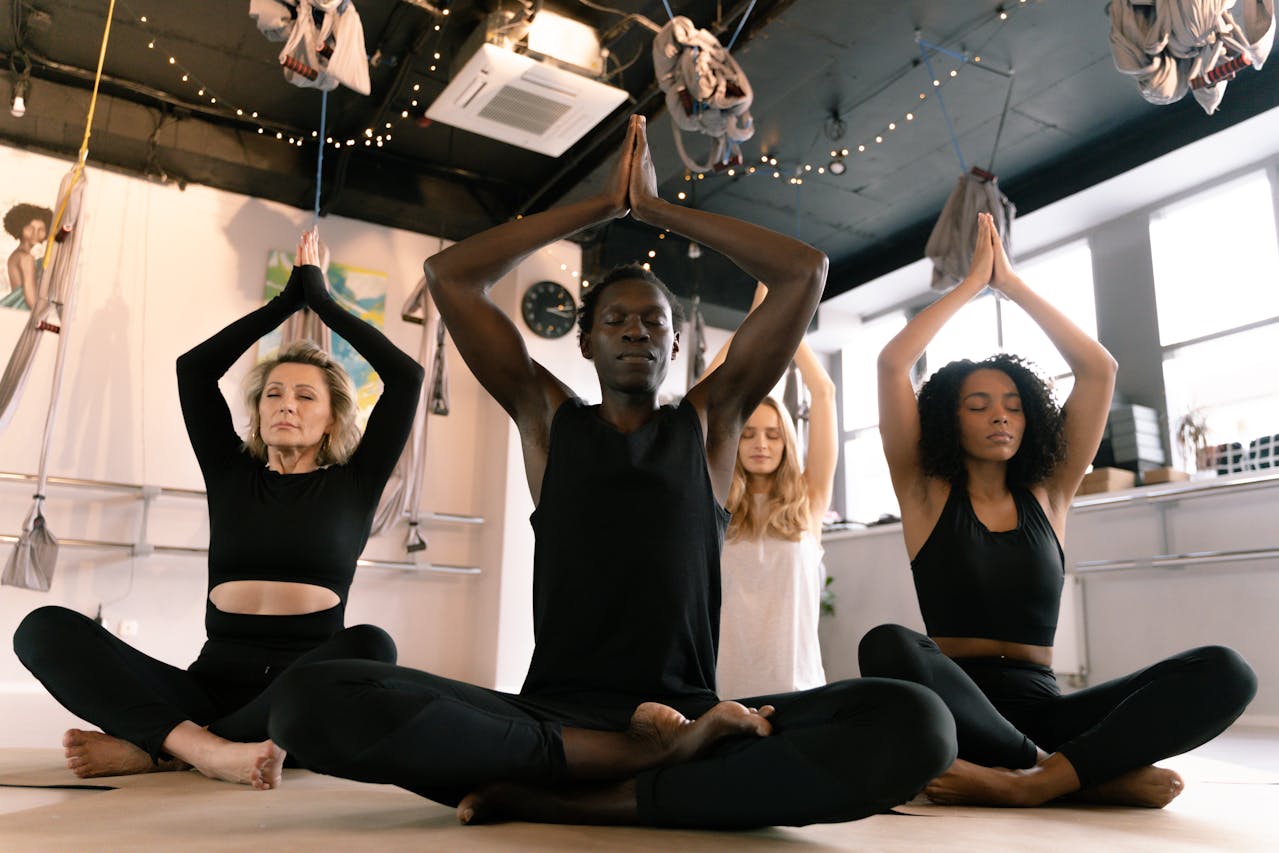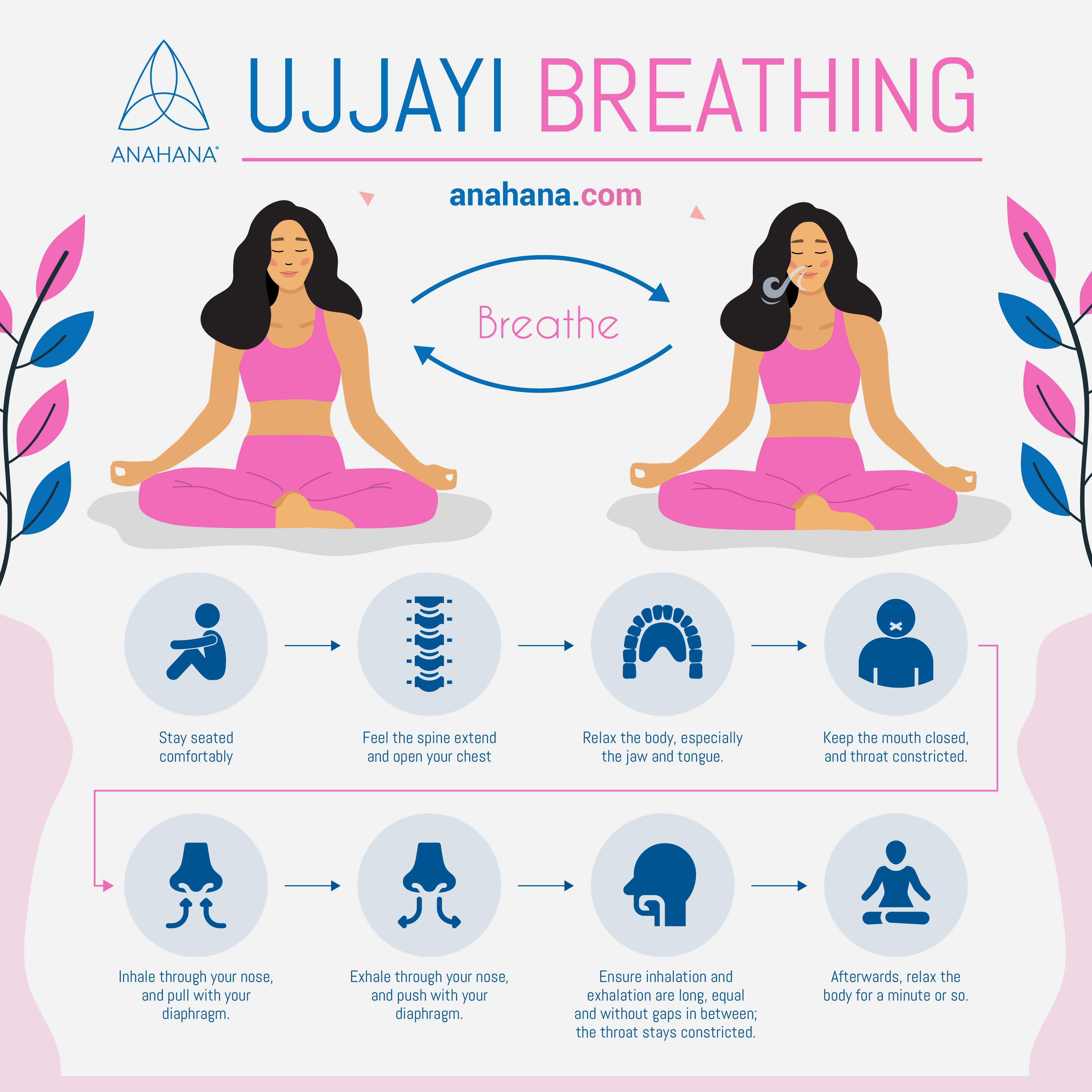
Table of Contents
One of the most prevalent forms of pranayama, the benefits of ujjayi breathing include improving concentration and relaxation. Due to its sound, it’s been called ocean breath, “Darth Vader” breath, and victorious breath for its properties. It’s also a good warm-up exercise for voice professionals.
Ujjayi Breathing Explained
Pronounced “oo jai,” Ujjayi Breathing, also known as the “ocean breath” or yogic breathing, is often used as an opening technique in yoga practice for its mind-calming effect.
It’s one of the most common forms of Pranayama breathing exercises performed alongside asana practice.
The Ujjayi Breathing is performed by constricting the throat, creating a sound resembling a whisper.
As one of the most common forms of yoga breathing exercises, there are no known risks associated with Ujjayi Breathing.
Benefits of Ujjayi Breathing
According to the National Center on Health, Physical Activity, and Disability, practicing Ujjayi Breathing helps:
- Improve concentration and relaxation
- Regulate body temperature
- Raise internal body heat
It’s also reportedly effective in cardiovascular changes caused by stress and anxiety. When practicing yoga poses, ujjayi breath helps practitioners to stay conscious of their breath.
Ujjayi comprises the Sanskrit terms ud “a superior sense or of power,” and jaya “victory, success, or conquest.” Together, it suggests that this breathing technique is the superior path to victory.
Process of Ujjayi Breathing
When practicing this breathing technique, people intentionally squeeze the back of the throat, specifically the glottis and epiglottis muscles, to make a narrow airway tunnel close to a straw’s phonation.
This causes small amounts of oxygen to get to the lungs through the glottis slowly, creating an “ocean wave” like noise.
The air bounces around in the airway due to the slight constriction and the narrowness, increasing the time it spends in the nasal cavity and warming the air with body temperature.
But more importantly, it helps to coordinate between the lungs and the central nervous system. As the Ujjayi pranayama happens, the increased oxygen supply excites the cardiovascular muscle and regulates and drops the heart and respiration rate alongside the blood pressure.
Unlike shallow breathing, slow breathing lowers the sympathetic activity but ups the parasympathetic activity.
The parasympathetic nervous system regulates the bodily systems active during standby, such as resting and digestion, so ujjayi breath is a great tool to shift away from fight-or-flight impulses, which aren’t good for the body to maintain for long periods.
When to Practice Ujjayi Breathing
- During Yoga Practice: Ujjayi breath is commonly used in yoga to enhance the mind-body connection and maintain focus. It helps regulate breathing, creates a soothing sound that can be meditative, and promotes a sense of calmness.
- During Stressful Situations: Ujjayi breath can be employed in stressful situations to help reduce anxiety and promote relaxation. Its slow and controlled nature can activate the parasympathetic nervous system, which counteracts the "fight or flight" response and induces a feeling of tranquility.
- Physical Exercise: Ujjayi breath can be applied during physical exercises like weightlifting, Pilates, or running. It aids in maintaining a steady rhythm of breathing, prevents breath holding, and ensures a steady supply of oxygen to the muscles, improving endurance and performance.
- Meditation and Pranayama: Ujjayi breath can be used during meditation and pranayama (breath control) practices. The deep, audible breath helps anchor the mind to the present moment, enhancing mindfulness and concentration during meditation and fostering a sense of inner awareness.
How to Practice Ujjayi Breath

- Stay seated comfortably.
- Feel the spine extend and open your chest.
- Relax the body, especially the jaw and tongue.
- Keep the mouth closed and throat constricted so the breathing sounds like a whale’s cry. It’s been described as trying to whisper “heee” while inhaling and “haaa” while exhaling, all with the mouth closed.
- Inhale through your nose and pull with your diaphragm.
- Exhale through your nose and push with your diaphragm. Ensure inhalation and exhalation are long, equal and without gaps in between; the throat stays constricted.
- Afterwards, relax the body for a minute or so.
Ujjayi breath should feel balancing and calming. Try to breathe through the mouth first, like when attempting to fog up a window, then slowly shift to the nose. Sometimes, it’s easier to think of it as constricting the glottis (i.e. vocal cords).
Precautions of The Ocean Breath
There are no known risks associated with Ujjayi Breathing. As this technique is often used at the beginning of the Hatha yogapractice, there is also no need to perform it to the exhaustion of any muscle before going into the yoga postures.
If a practitioner’s lung capacity, breathing proficiency, or any other aspect of their cardiopulmonary function isn’t functioning optimally, Ujjayi Breathing should be performed with special care and attention.
Frequently Asked Questions
Is Ujjayi Pranayama harmful?
No, Ujjayi Pranayama breathing exercises are not harmful. It is a gentle form of yoga breathing exercise that can improve respiratory system health and bring clarity and balance to the mind and body. When done correctly, it is a safe practice that can be enjoyed by beginners and experts alike.
Is Ujjayi diaphragmatic breathing?
No, Ujjayi breathing is not diaphragmatic breathing. Diaphragmatic breathing is a type of deep breathing that utilizes the diaphragm.
At the same time, Ujjayi is a type of pranayama or breath control in which the throat constricts to create sound while inhaling and exhaling.
Which yoga style is Ujjayi breath most commonly used in?
Ujjayi breath is commonly used in Hatha Yoga practice and Vinyasa yoga.
What is the Ujjayi sound?
The Ujjayi sound is a type of breath used in many yoga practices. It is a slow, deep, and relaxed breath with a slight constriction at the back of the throat, creating an ocean-like sound.
References
Ujjayi Pranayama Breathing 101
Ujjayi Breathing: How To & Benefits Of Practicing Ocean Breath
Ujjayi Breathing for Yoga, Meditation and, Better Sleep | The Art of Living
11 Ujjayi Breath Benefits (Plus Practice Tips) • Yoga Basics
Learn the Ujjayi Breath, an Ancient Yogic Breathing Technique – Chopra
Disclaimer
The contents of this article are provided for informational purposes only and are not intended to substitute for professional medical advice, diagnosis, or treatment. It is always recommended to consult with a qualified healthcare provider before making any health-related changes or if you have any questions or concerns about your health. Anahana is not liable for any errors, omissions, or consequences that may occur from using the information provided.

By: Meriah McCauley
Meriah McCauley is passionate about the art and science of holistic health and healing. She explored the power of yoga through working with her mentor and guru Dr. Don Stapleton in Costa Rica. She also received a Masters in Psychology from Columbia University, specializing in Spirituality and the MindBody connection. Meriah now offers coaching, yoga teacher trainings, and Holotropic Breathwork for personal development. She loves to connect with those on this path.
